Our vision changes as we age. One common condition is low vision. This condition — which can’t be corrected with glasses, contacts, medication or surgery — makes it hard to participate in daily activities, like driving, recognizing faces or clearly seeing screens.
If you or a loved one is having trouble seeing, make an appointment with your primary care provider. Some causes of low vision may be related to a serious underlying health issue.
Common Causes of Low Vision
Most cases of low vision and vision loss in older adults are caused by injury and disease, such as:
Age-Related Macular Degeneration (AMD)
AMD is the primary cause of vision loss among older Americans, according to data from the National Eye Institute. Your risk of developing the disease is higher if you:
- Have a family history of AMD
- Are over 55
- Are white/Caucasian
- Smoke/vape
AMD usually impacts both eyes. As it progresses, you may notice vision changes like:
- Difficulty seeing in low light
- Colors looking less vivid
- Mild blurriness or blank spots, especially in your central vision
- Straight lines appearing wavy or crooked
Because AMD develops gradually, it’s hard to detect early. That’s why the NEI encourages seniors to have an eye exam every year.
The most treatable forms of AMD are:
- Intermediate AMD in one or both eyes is usually treated with over-the-counter AREDS 2 dietary supplements that slow the disease’s progress. Before taking this or any supplement, talk with a healthcare professional.
- Wet AMD can be treated with anti-VEGF drugs injections or a combination of injections and laser treatment called photodynamic therapy.
Unfortunately, there are no treatments for early AMD or for late-stage dry AMD.
Cataracts
Cataracts can occur in one or both eyes when the proteins in your eye break down creating a cloudy area on your lens. More than half of Americans 80 or older either have cataracts or have had surgery to get rid of them, according to the NEI.
Your risk of developing the disease is higher if you:
- Have a family history of cataracts
- Have spent a lot of time in the sun
- Smoke or drink too much alcohol
- Live with certain health conditions, including diabetes
- Have had an eye injury, eye surgery or upper body radiation treatment
- Take steroids
Cataracts develop slowly, making it hard to detect symptoms early:
- Faded colors
- Double vision
- Lights, sunlight or headlights seem too bright or have a halo
- Clouded or blurred vision
- Reduced ability to see well at night
Since these symptoms are also associated with other vision issues, visit your doctor if you experience any of them. Cataracts are easily removed with surgery — one of the most common procedures performed in the U.S.
Diabetic Retinopathy
Diabetic retinopathy develops when high blood sugar damages the part of your eyes that detects light. More than 4 million adults have DR.
Anyone with diabetes can develop DR. Your risk is higher, however, if you:
- Developed gestational diabetes during pregnancy
- Have lived with diabetes for a long time
- Have high blood pressure or high cholesterol along with diabetes
This is why people living with diabetes must get comprehensive dilated eye exams at least annually, even if their vision seems fine.
The most noticeable early symptom of DR is trouble seeing near or far. As the disease gets worse, blood vessels in your eye may start to bleed, creating dark spots or streaks resembling cobwebs. If you notice this, make an appointment with your medical provider immediately. Early intervention is crucial to avoid other serious conditions like:
- Diabetic macular edema, which causes blurred vision
- Retinal detachment, when the retina is pulled away from the back of your eye
- Neovascular glaucoma, which increases pressure in the eye
There is no way to undo the damage done by DR. Early intervention and treatment are the best ways to keep the condition from getting worse. Treatments include injections, laser treatments and surgery.
Glaucoma
Glaucoma is a family of eye diseases affecting the optic nerve and potentially causing vision loss or blindness. Anyone can develop glaucoma, but your risk is higher if you:
- Have a family history of glaucoma
- Are over age 60, especially for people of Hispanic/Latino heritage
- Are over 40 and Black
Glaucoma develops so slowly you may not notice symptoms, which usually begin with your side vision, particularly on the sides close to your nose. The only way to find out if you have glaucoma is to get a comprehensive dilated eye exam. Talk to your primary care doctor and your eye doctor about your risk factors for the disease.
Glaucoma has no cure, so early treatment is vital to slowing or stopping the damage and protecting your eyesight. Eye drops, laser treatment and surgery are common treatments.
Taking care of our vision is always important, especially as we age. We can improve eye health with good nutrition, regular exercise and smoking cessation. Talk to your primary care physician about your risk of eye disease and be honest about symptoms. Early detection is the best way to avoid or manage the impacts of low vision.
Don’t disregard professional medical advice, or delay seeking it, because of what you read here. This information is not intended as a substitute for professional consultation, diagnosis or treatment; it is provided “as is” without any representations or warranties, express or implied. Always consult a healthcare provider if you have specific questions about any medical matter, and seek professional attention immediately if you think you or someone in your care may be experiencing a healthcare condition or medical emergency.




